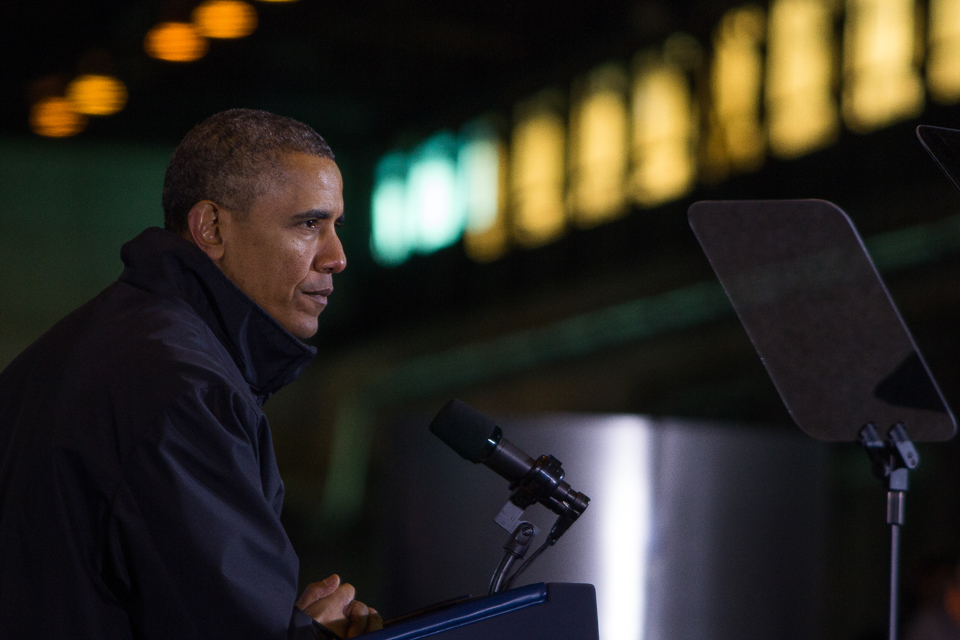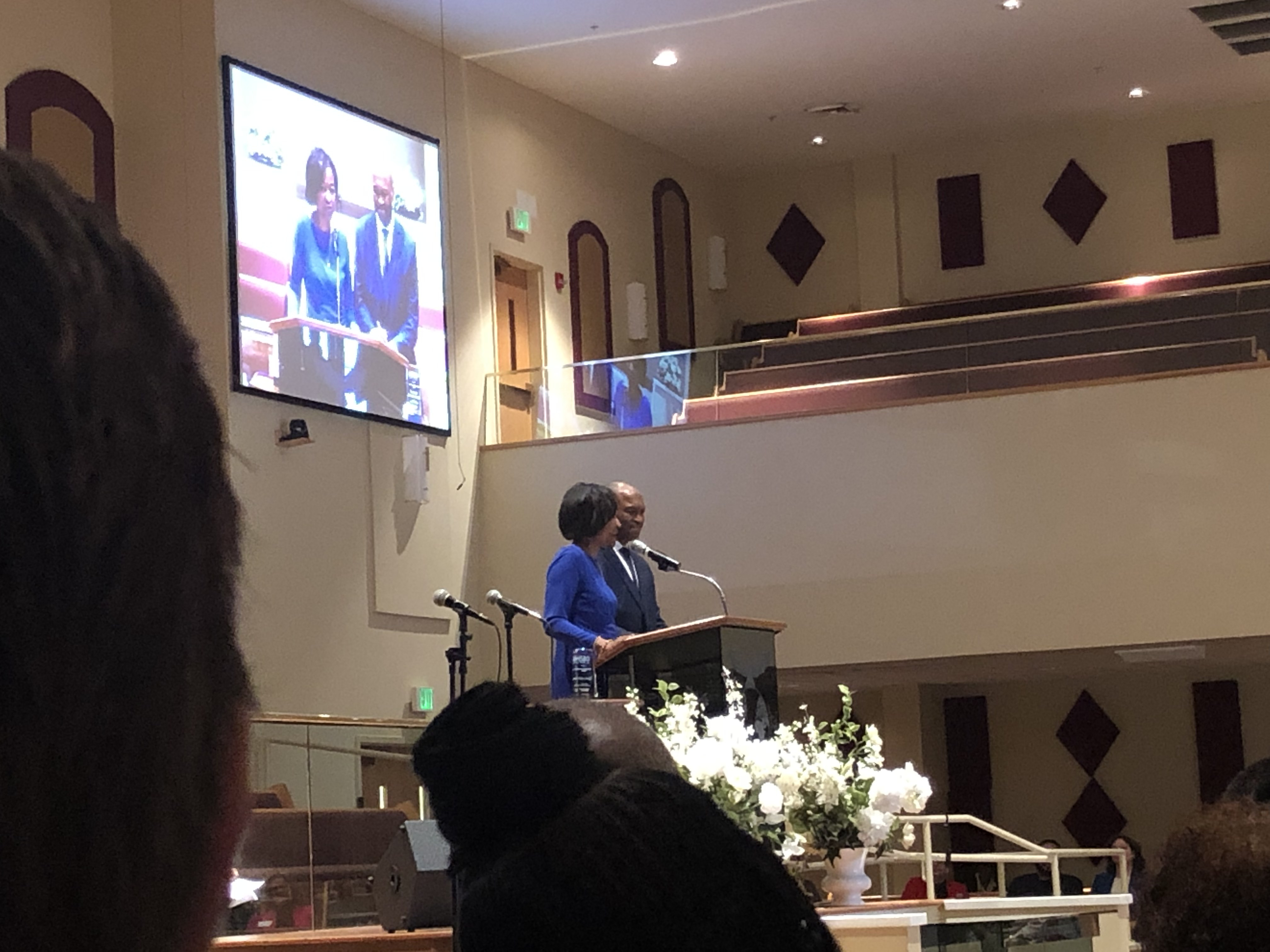

By Pat Higgins and Aaron Warnick | The Duquesne Duke
President Barack Obama traded a suit jacket for a collared fleece pullover to stay warm Wednesday during his visit to Pittsburgh where he signed an order to establish a new savings plan and pushed his strategy for manufacturing jobs.
U.S. Steel’s Mon Valley Works Irvin Plant in West Mifflin was the president’s second stop on his two-day, four-city blitz following his State of the Union address Tuesday night. While some remarks were repeated nearly verbatim, Wednesday’s talk had a local flavor for the freezing ensemble of Pittsburghers, steel workers and local government officials.
Massive indoor heaters stifled the lingering polar vortex chill somewhat, but everyone inside still needed to have their jackets buttoned up and warm hats firmly in place. The crowd, which included new Pittsburgh mayor Bill Peduto, Steelers chairman Dan Rooney, and a host of other local a-listers, waited in the cold for over two hours to the same two or three songs on loop while the president toured the facilities.
Just after 2 p.m. Obama was introduced by Mario Longhi, president and chief executive officer of U.S. Steel Corporation.
“[Manufacturing] jobs pay family-sustaining wages, provide good benefits, offer substantial workforce development opportunities and drive innovation,“ Longhi said. “We share the administration’s goals for further investment into job training and development”
In his speech, the president laid the groundwork of a four-part agenda aimed at creating opportunities to “speed up economic growth and strengthen the middle class,” and later signed a presidential memorandum which he personally delivered to Secretary of the Treasury Jacob Lew off-stage.
The memorandum authorized Obama’s plan to create a new way for working Americans without 401k’s to start their own retirement savings, a plan he calls “MyRA.” The plan calls for a new type of savings bond in which workers can contribute through automatic reduction of their paychecks, backed by the U.S. federal government “to restore opportunity to every single person who’s willing to work hard and take responsibility in this country.”
The savings plan allows workers to deposit as little as $5 at a time into accounts that will earn modest interest rates.
In addition to signing and delivering the memo to Lew, the president laid the four pillars of an opportunity agenda that he hopes will stimulate a “year of action” in America.
He spoke of new steps he and Congress can take to create new jobs in American manufacturing, energy and innovation, as well as train more Americans “with the skills we need to build those jobs.”
He reiterated that lawmakers must “guarantee every child in America a world-class education,” and most importantly that government must “make sure that hard work pays off.”
Obama, taking a page from his State of the Union address, called for a year highlighted by political progress instead of gridlock.
“I don’t know what their plans are, but I choose a year of action,” he said. “Because too many Americans are working harder than ever just to get by, let alone get ahead.”
The president’s message to the workers at the plant was an echo of his domestic portion of his State of the Union address. The reinforcement of the American worker is the keystone of the president’s call for a “year of action.”
“We are stronger when America fields a full team,” Obama said Tuesday night in a plea to business leaders to “give more long-term unemployed workers a fair shot that new job.”
On Tuesday, President Obama stressed the need to help the middle and lower classes.
He also claimed that America had surpassed China as the top nation to invest in. He directly called on Congress to restore funding to research so that “we can unleash the next great American invention.”
“The nation that goes all-in on innovation today will own the global economy tomorrow,” he said. “China and Europe aren’t standing on the sidelines. Neither should we.”
He shared his desire to get the United States off of a “permanent war footing” and to set examples to the world by closing Guantanamo Bay Prison and regulating the collection of data by private citizens.
However, he spent most of the time describing his plan for America in the global economy.
“That’s why I believe this can be a breakthrough year for America,” he said from the chamber of the U.S. House of Representatives. “After five years of grit and determined effort, the United States is better-positioned for the 21st century than any other nation on Earth.”





This is yet another inept government “solution” to a mis-identified problem.
The problem for the people identified isn’t that it’s their “choice” not to save, its an inability to make ends meet no matter how much they cut their “lifestyle” (so-called) and expenses to the bone.
For that matter, the “solution” to the so-called “problem” already exists: it’s called a money market account.
And even then, the “solution” from this administration is typical: they make it “mandatory” (i.e.,automatic and unchangeable, once a person selects the amount to deduct from payroll). And in the end, it is still ineffective: taking $5 out of a person’s weekly paycheck (which may even result in the person’s having to cut a necessary item from his/her budget), the maximum the person could save even with compound interest over a working lifetime still amounts to peanuts — around $7,000.
It is to be hoped that the government gets out of the business of creative “solution” making and “problem” solving, because the real problem is government’s stifling of economic creativity. The latter is what leads to job creation and real economic growth, not a nanny-state nation of Keynesian-policy dependency.